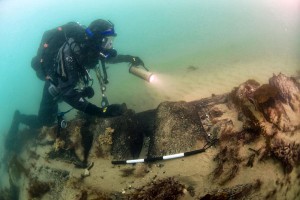Exploring England’s shipwreck heritage
- On 09/12/2013
- In Parks & Protected Sites
- 0 comments

By Carly Hilts - Current Archaeology
From sea shanties to the shipping forecast, boats and the sea are woven into the fabric of English life and culture, and yet we only began to take shipwrecks seriously as historical and archaeological monuments in the 1970s.
Chris Catling looks at what we have gained in the 40 years since the passing of the landmark Protection of Wrecks Act in 1973.
England’s rocky shores and sandy estuaries are littered with the remains of historic ships and boats.
Shipwrecks, in fact, constitute the largest category of recorded monument, with some 37,000 shipwreck ‘events’ on record, ranging in date from the Bronze Age to the more recent ship and submarine casualties of two World Wars (not to mention dirigibles and aeroplanes lost on the seabed).
To put that in perspective, there are 14,500 places of worship in England considered to be of sufficient architectural or historic interest to be included in the National Heritage Register.
And whereas the number of historic places of worship is relatively static, the number of known wreck sites is growing all the time; what we know now represents just a fraction of the actual number of historic shipwrecks on the seabed.
Two new sites of great importance were discovered as recently as 2006, when archaeologists found two adjacent wreck sites prior to dredging works in the River Thames – those of the London, built at Chatham in 1656 (soon to have its own CA feature), and the King, a vessel thought to have foundered during the First Anglo-Dutch War (1652-1654).
Systematic surveys funded by English Heritage are taking place around England’s coast to try to pin down exactly what has survived.
The Modern Wrecks Project, for instance, has so far added 500 new records to the wreck database of ships lost since 1945.
This has revealed new patterns in the type of vessel lost: for example, the large number of fishing trawlers that sank in the 1970s and 1980s, especially those from former Soviet Eastern Europe.
Another recording programme called the National Hulks Assemblage Project is looking not at ships wrecked as a result of storms like the one that lashed England and the near Continent on St Jude’s Day, 28 October 2013, but vessels deliberately abandoned.
Add a comment